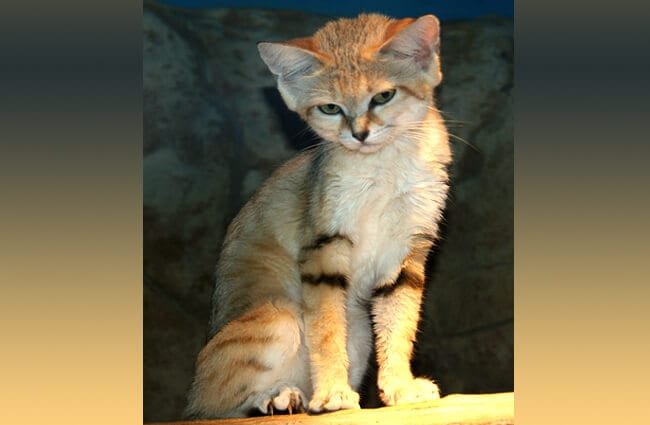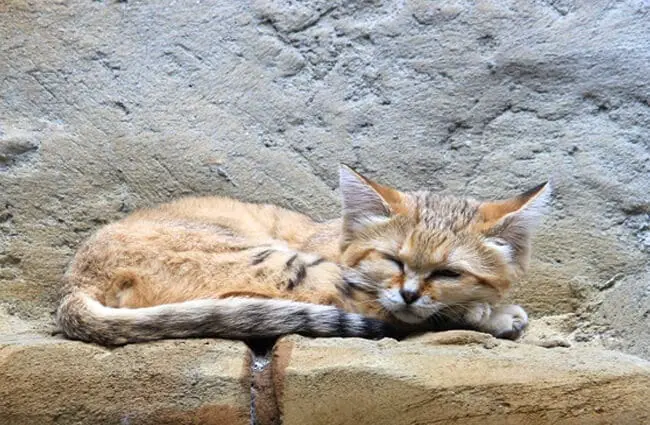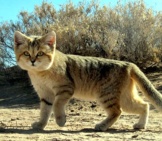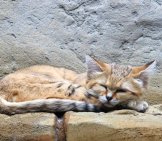Sand cats, also known as “sand dune cats,” are desert dwelling felines native to Northern Africa, Central Asia, and the Middle East. While these cute cats look quite similar to your average housecat, be warned they are 100% wild animals. Sand cats have not been domesticated in any way, and are actually ferocious little predators. Read on to learn about the sand cat.
Description of the Sand Cat
Sand cats are a pale tan or sandy color (to match all the sand of course), with some dark spots or stripes on their fur. Their tails are tipped with black, with a few black bands around them. There are two dark stripes on their upper forelegs. Their ears are quite large, which helps heat escape in the hot desert temperatures.
Interesting Facts About the Sand Cat
Don’t let their cuteness fool you… these little cats are fierce predators! They are unique felines due to their desert habitat, and have a few characteristics to help them survive this environment.
- Desert Dwelling Feline – Sand dune cats are the only cats that live primarily in desert regions. Other felines may range in deserts occasionally, but sand cats specialize in surviving within these arid environments.
- Purr-fect Hiding Place – Where better to snooze during the hot desert day than a nice cool burrow in the sand? Sand cats are experts at burrowing, and spend much of their naptime in shallow burrows. They also dig to seek out their prey, most of which also spends its time underground.
- Furry Feet – Those fuzzy little feet aren’t just for show! Sand cats have heavily furred feet to help keep them from burning their toes on hot sand. The fur protects sand cats’ feet by providing a barrier between the sensitive footpads and the scorching sand and rock. They have so much fur on their feet that they don’t leave behind footprints!
- Water? Who Needs It! – Because water is scarce in the desert, sand cats can go long periods of time without drinking. Instead, they receive most of their moisture from the prey that they eat. Sand cats can sometimes go months without drinking.
Habitat of the Sand Cat
Sand cats live exclusively in desert regions. They are found in very arid habitats with little to no vegetation. Instead, they live in dry, sandy plains and rocky valleys. Conditions are extreme in the desert, and temperatures can reach 124º F during the day, and 31º F at night. Because they need to burrow to escape the heat, sand cats are found only in soft soils.
Distribution of the Sand Cat
These cats are native to Northern Africa, the Middle East, and Central Asia. They are restricted mainly to the Sahara desert in Africa, the Arabian Peninsula, and parts of Iran, Afghanistan, Turkmenistan, and Pakistan. Their ranges are influenced by the presence of desert as well as land development and soil composition.
Diet of the Sand Cat
Sand dune cats prey on rats, mice, hares, birds, snakes, spiders, and insects. They commonly make lunchmeat out of venomous snakes and spiders. Because they live in such a harsh environment, sand dune cats must be opportunistic feeders. The must eat whatever they can find, because they have no other choice!
Sand Cat and Human Interaction
Human activity is rapidly degrading vital sand cat habitat. This is causing their populations to decrease at an alarming rate. Livestock grazing near sand cat habitat is particularly damaging. While these cats do not need vegetation, their prey does. When this vegetation is destroyed, the sand cats can starve. Sand dune cats also frequently fall victim to traps laid for other predators that eat farmers’ livestock.
Domestication
Sand cats have not been domesticated in any way.
Does the Sand Cat Make a Good Pet
No. Because sand cats are threatened, animals taken illegally for the pet trade can seriously damage wild populations. They are very sensitive animals, and do not do well in facilities not equipped for their needs.
Sand Cat Care
In zoos, sand cats must be provided with very particular care. They are provided with plenty of hiding spaces and burrowing opportunities, and have access to round the clock medical care. They are fed a diet of mice or rats, bones, and rib bone meat at the Smithsonian’s National Zoo.
Behavior of the Sand Cat
Because the desert is so extremely hot, animals benefit from nighttime activity. Avoiding the heat, sand cats are nocturnal and hunt at night. They are mainly solitary animals, but not highly territorial. While they don’t socialize with other cats, they will occasionally share burrows. They do not share the same space in the burrow, but instead occupy it while the other animal is away.
Reproduction of the Sand Cat
Populations of sand cats in different locations will breed at different times of year. After mating, the female sand cat has a gestation period of 59 – 67 days. The litter usually consists of 2 – 4 kittens, with numbers up to 8 occurring as well. The kittens will begin to hunt for their own prey between 6 and 8 months of age. They reach breeding age by 14 months old, and can produce a litter of their own at that time.











![Red Angus Closeup of a beautiful Red Angus cowPhoto by: U.S. Department of Agriculture [pubic domain]https://creativecommons.org/licenses/by/2.0/](https://animals.net/wp-content/uploads/2020/03/Red-Angus-4-238x178.jpg)












![Red Angus Closeup of a beautiful Red Angus cowPhoto by: U.S. Department of Agriculture [pubic domain]https://creativecommons.org/licenses/by/2.0/](https://animals.net/wp-content/uploads/2020/03/Red-Angus-4-100x75.jpg)

